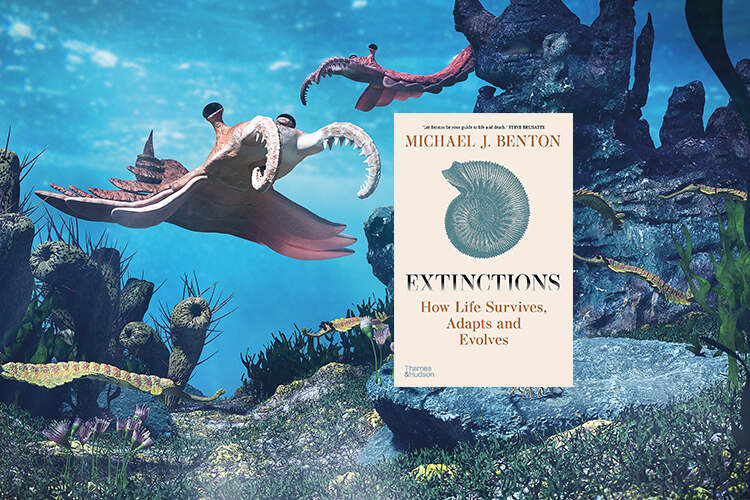
A disturbingly uplifting but easily accessible read on the mass extinction events throughout history, and why they might be better than we realise
Book of the month
Review by Mark Rowe
What doesn’t kill you makes you stronger, argued the German philosopher Friedrich Nietzsche. The message from this engrossing book is that mass extinctions are even better for the collective global constitution, making our planet and the species that survive and emerge from the wreckage all the more robust and diverse.
The book’s bleak title implies a worthy if rather grim read. Instead, it’s fascinatingly and possibly disturbingly uplifting. The Earth has curated at least five mass extinctions and each and every one has, in the long term, left the world a better place.
Author Michael J Benton differentiates between classifications of extinction. The dodo, whose definitive extinction can be laid at the door of a gun or club, is an example that quickly leaps to mind, but then there are also what are known as background extinctions. Species come and go, dying out because food runs out locally, or perhaps the climate changes, or because a ‘vigorous incomer steals all the food or space’.
In contrast, mass extinction events are the headline acts of evolution. They see 50–90 per cent of all species knocked out at the same time, thanks to volcanic eruptions, for example, or meteorites or ocean acidification. Such cataclysmic events, it turns out, are good. They have a creative aspect. Life always bounces back. Surviving species take over, occupying strange ecosystems that suddenly have yawning gaps where dominant plants and animals once were. After a few thousand generations, the food webs build back, ecosystems rebuild.
The slow recovery from mass extinctions often sees the emergence of something completely new, such as the first swimming scallop or the first dinosaur. Mass extinctions at the end of the Permian and Triassic periods triggered or enabled the evolution of modern-style ecosystems featuring coral reefs, sharks, flies, conifers, crocodiles and land mammals. The Cambrian Period was topped and tailed by extinction events, but in between came the Cambrian explosion, unfolding over 36 million years and perhaps the biggest revolution of all, with the emergence of skeletons and arthropods as large as dogs.
Benton’s tone is refreshing, displaying a sense of almost childlike wonder at the world and locating a sweet spot that’s authoritative but readable, modest, occasionally witty and never pompous. We learn of incredible, long-extinct species such as the worm-like seven-spined Hallucigenia or an arthropod, Opabinia, with five eyes on stalks.
He even downplays his role in identifying a sixth large extinction event, which has long represented something of a white whale for palaeontologists. Benton makes a strong case for locating what is known as the long-lost Carnian Pluvial Episode, which happened during the late Triassic, around 237–227 million years ago, and was characterised by heavy rainfall. The author, along with two colleagues, first solidified (or possibly, he admits, ‘invented’) the theory after identifying a major extinction of sea lilies around the same time as signs of climate change were noted in what is modern-day Somerset. The extinction unfolded over roughly a million years and saw the demise of 34 per cent of genera, including the rhynchosaur, a pig-like relative of crocodiles and dinosaurs. But the event triggered another ecological reset that saw the flourishing of modern-day plants, insects and vertebrates.
Extinctions is easily accessible to the lay reader, comprising six sections, each with three or four concise chapters that wade chronologically from the deep past to the industrial age, documenting the first mass extinction about 444 million years ago, via the cataclysmic end-Permian event, also known as the Great Dying. There are colour plates that recreate long-gone species and a handy GCSE-level timeline is tucked at the back to put events in context. The narrative style changes frequently to avoid monologues and at one point you’re watching events unfold through the eyes of a soon-to-be-extinct dinosaur, a technique that works better – is more engaging – than it sounds.
One sobering takeaway is that mass extinctions – obliteration aside – don’t really mean much for the species involved: give or take a few million years, they were doomed anyway. Mammal and bird species typically last four million years if they’re lucky; molluscs and plants perhaps ten million years. It’s properly existentialist stuff that makes you wonder what Jean Paul Sartre might have written had his interest been palaeontology.
The thread that loosely runs through the book – subtly done, rather than banging the reader over the head with a saucepan – is what we can learn from previous extinction events to usefully apply to our own era of climate change and whether we can do anything to avoid shortening our time on the planet. We’re perturbing ecosystems in a way that no other species ever has before. Science may at some point allow us to de-extinct the woolly mammoth, possibly the dodo (Benton chews over the moral case for doing so), but is there space for the animals we’ve killed off? Humans have squeezed the space for wild nature so much in the past 200 years that there’s no longer room for the ten million species alive today, let alone for reviving the back catalogue.
From the planet’s point of view, it doesn’t really matter what we do – whether we do the right things or just stick our fingers in our ears. The history of extinctions shows how the evolutionary tree gets reshaped time and time again; so even if we do get it right, it’s a nailed-on certainty that our own branch will still snap off at some point. The world will survive, adapt and, in the long term, probably be a better place, growing back even more robust, as it has after every previous mass extinction event.




